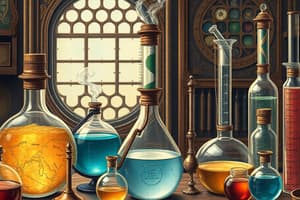Podcast
Questions and Answers
The degree of agreement between the results obtained by the same observer under the same conditions is called ______.
The degree of agreement between the results obtained by the same observer under the same conditions is called ______.
repeatability
The closeness of two or more measurements to each other is referred to as ______.
The closeness of two or more measurements to each other is referred to as ______.
precision
The type of pipette that allows for multiple measurements at once is called a ______ pipette.
The type of pipette that allows for multiple measurements at once is called a ______ pipette.
multichannel
One common source of error in pipetting is when the pipette tips are not well fitted to the ______.
One common source of error in pipetting is when the pipette tips are not well fitted to the ______.
To validate a pipette, one often checks the percentage ______ of the pipette's volume output.
To validate a pipette, one often checks the percentage ______ of the pipette's volume output.
The mean volume measured is ______ µl.
The mean volume measured is ______ µl.
A percentage precision of ______ to 2% indicates good pipetting.
A percentage precision of ______ to 2% indicates good pipetting.
The standard deviation (SD) of the pipetting values is ______.
The standard deviation (SD) of the pipetting values is ______.
To determine the percentage precision, you need to use the formula: Precision (%) = ______ x 100 / Mean volume.
To determine the percentage precision, you need to use the formula: Precision (%) = ______ x 100 / Mean volume.
To perform the pipetting protocol correctly, one must weigh and ______ the mass of the beaker.
To perform the pipetting protocol correctly, one must weigh and ______ the mass of the beaker.
Flashcards are hidden until you start studying
Study Notes
Basic Laboratory Skills
- Essential skills required for biochemistry laboratories include accuracy, precision, repeatability, and reproducibility.
Repeatability and Reproducibility
- Repeatability: Agreement of results when the same observer conducts experiments under the same conditions.
- Reproducibility: Agreement of results across different observers and conditions, reflecting variable factors such as location and instruments.
Accuracy and Precision
- Accuracy: Closeness of a measurement to the true or correct value.
- Precision: Closeness of multiple measurements to each other, irrespective of accuracy.
- Measurement scenarios can yield high accuracy with low precision or vice versa.
Pipettes and Pipetting
- Measuring volumes typically involves using pipettes, with accuracy and precision being critical factors.
Types of Pipettes
- Glass Pipette: Typically graduated for volume measurement.
- Variable/Micropipette: Adjustable for precise measurements, available in single-channel and multichannel options.
- Droppers/Pasteur Pipette: Used for transferring small volumes of liquid.
Pipette Fillers
- Rubber Bulb Fillers: Common, flexible materials for filling glass pipettes.
- Plastic Fillers: Also available for use with glass pipettes, providing alternatives based on preference.
Pipette Tips
- Different sizes of tips correspond to specific volume ranges:
-
1000 µL
- 100 – 1000 µL
- 10 – 200 µL
- 0 – 10 µL
-
Pipetting Techniques
- Forward Pipetting: Standard technique where the plunger is pushed down to aspirate and release liquid.
- Reverse Pipetting: Alternative method beneficial for viscous liquids or to prevent contamination.
Sources of Pipetting Errors
- Poor fitting of pipette tips, incorrect plunger use, incomplete liquid transfer, and varied pipetting speed can all impact volume accuracy.
Validation of Pipette Performance
- Percentage Accuracy: Assessed by comparing pipetting outputs to set values (e.g., for a 1000 µL pipette set to 900 µL).
- Acceptable accuracy is within 99-101%, indicating good performance.
Calculating Percentage Precision
- Involves measuring standard deviation (SD) based on multiple pipetting trials to gauge consistency.
- Precision percentage decreases with higher SD; a 0-2% precision indicates effective pipetting technique.
Experimental Protocol
- Mass measurements involve weighing a beaker, aspirating a liquid sample, dispensing into the beaker, and recording mass to calculate volume in µL.
- At least three replicate measurements enhance reliability.
Post Lab Questions
- Tasks include calculating percentage accuracy and precision from recorded volumes, summarizing findings, and evaluating forward vs. reverse pipetting with pros and cons for each method.
Studying That Suits You
Use AI to generate personalized quizzes and flashcards to suit your learning preferences.




